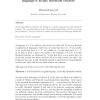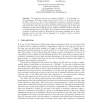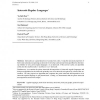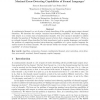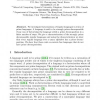CORR
2011
Springer
13 years 8 months ago
2011
Springer
The complexity of the isomorphism problem for regular trees, regular linear orders, and regular words is analyzed. A tree is regular if it is isomorphic to the prefix order on a r...
FUIN
2010
14 years 9 days ago
2010
Abstract. A (combinatorial) channel consists of pairs of words representing all possible inputoutput channel situations. In a past paper, we formalized the intuitive concept of “...
MST
2007
14 years 1 months ago
2007
Odometers or “adding machines” are usually introduced in the context of positional numeration systems built on a strictly increasing sequence of integers. We generalize this no...
JUCS
2002
14 years 1 months ago
2002
: We study additive distances and quasi-distances between words. We show that every additive distance is finite. We then prove that every additive quasi-distance is regularity-pres...
IPL
2007
14 years 1 months ago
2007
A new algorithm is presented for testing if a regular language is locally threshold testable. The new algorithm is slower than existing algorithms, but its correctness proof is sh...
IANDC
2007
14 years 1 months ago
2007
The edit distance (or Levenshtein distance) between two words is the smallest number of substitutions, insertions, and deletions of symbols that can be used to transform one of the...
MST
2006
14 years 1 months ago
2006
The sequence selected from a sequence R(0)R(1) . . . by a language L is the subsequence of R that contains exactly the bits R(n + 1) such that the prefix R(0) . . . R(n) is in L. B...
FUIN
2007
14 years 1 months ago
2007
Intercodes are a generalization of comma-free codes. Using the structural properties of finite-state automata recognizing an intercode we develop a polynomial-time algorithm for d...
JALC
2008
14 years 1 months ago
2008
A combinatorial channel is a set of pairs of words describing all the possible input-output channel situations. We introduce the concept "maximal error-detecting capability&q...
DLT
2006
14 years 3 months ago
2006
We investigate factorizations of regular languages in terms of prime languages. A language is said to be strongly prime decomposable if any way of factorizing the language yields a...

